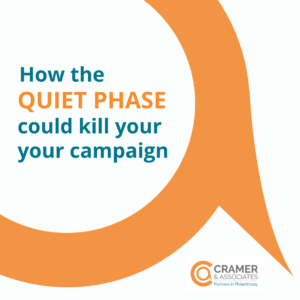Mike Schmidt, CFRE, Cramer & Associates, Executive V.P. & Partner
 For years, the ‘Quiet Phase’ has been a mainstay of most capital campaign strategies. Organizations were silent to the general public about projects and campaigns in order to secure volunteer leadership and lead gifts.
For years, the ‘Quiet Phase’ has been a mainstay of most capital campaign strategies. Organizations were silent to the general public about projects and campaigns in order to secure volunteer leadership and lead gifts.
This time was crucially secretive because if leadership gifts couldn’t be secured, organizations could adjust the scope of the project to decrease goal and not have to publicly show failure.
It also allowed donors to feel like insiders because they were hearing about the project before anyone else and were true stakeholders.
Here are 3 reasons why you should consider changing your Quiet Phase strategy:
- Being too quiet: when you finally get that meeting with your key stakeholder and they are surprised that they haven’t heard anything in the community about this. Their fear is leading a parade that no one else is going to follow. If you’re too quiet, it may erode your credibility and not generate the buzz you’ll need later.
- It’s not their idea: if you have been properly approaching this big initiative by conducting a strategic plan that engages stakeholders through interviews and surveys, they have an understanding about the need for the project and feel a sense of ownership in the decision-making process.
- Competition: While you’re in quiet mode, your competitors may be raising awareness about their financial needs. Many funders develop annual priorities and budget their giving over a multiple year period and other organizations are educating them on their upcoming financial needs for operating, programs, capital and other initiatives. As you approach with a significantly larger ask, their budgets may be allocated elsewhere.
Options for modifying your Quiet Phase:
- Expand your planning process: By including many more of your stakeholders into your strategic planning process, they develop a stronger sense of ownership in your vision. Increasing the Feasibility Study process with additional interviews and a large e-survey pool to be inclusive of everyone you plan on soliciting, dramatically increases your likelihood of campaign success.
- Raise awareness about the project need (but not the campaign!): If your project is a facility expansion, highlight that your programs are busting at the seams and that your ability to serve is limited. Many leaders will say, “We are planning on launching a $4 million new building project to help us . . .” and no one hears anything past the words ‘$4 million dollars.’ By positioning it as “We’re really challenged with our space limitations and a booming amount of clients to serve, therefore we’re exploring options for a new facility,” the stakeholder is more likely to ask about the program or your process for how you will move forward.
- Use phases: Breaking campaigns into a series of smaller phases, branded under a larger Master Plan umbrella, allows an organization to promote the Master Plan (that has its own theme) and then share the plans for the immediate initiative and its specific goal. Instead of having to state a significantly higher overall price tag, the current initiative goal can be shared, and the longer-term Master Plan can be explained as a range that will be executed as each sequenced initiative is achieved.
The Cramer Team has developed new approaches to tackle your next capital campaign, such as tweaking the Quiet Phase and other traditional elements. For more information on how to boost your campaign efforts, contact Cramer & Associates at www.cramerphilanthropy.com/contact.
Cramer & Associates is a nationally recognized philanthropic consulting firm that has been serving nonprofit organizations, corporations and foundations since 1987. Our full-service firm offers clients a wide range of services, including feasibility studies, campaigns, strategic planning, board training, development audits, events, executive searches and much more. The Cramer Team identifies organizations’ strengths and opportunities and develops campaigns that succeed, empowering organizations to impact their communities.




